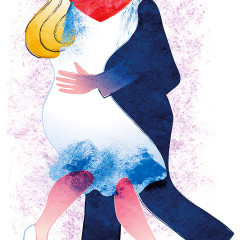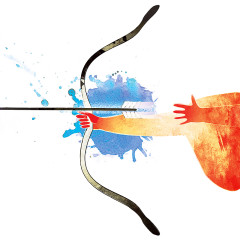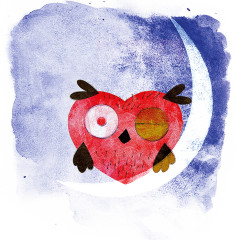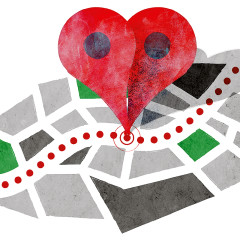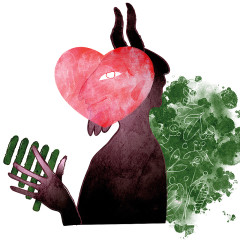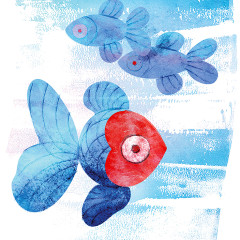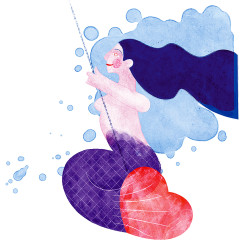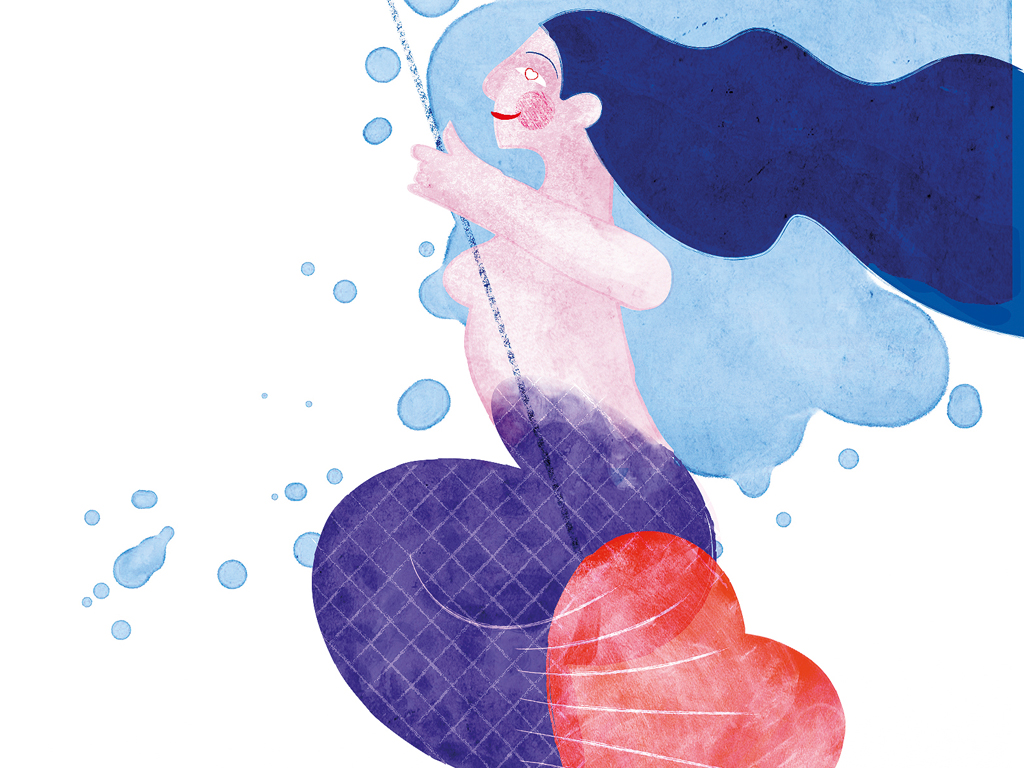
Quanti amori
Liberi, sognanti, incantati. Senza confini, etichette o identità. Un fantastico mosaico di passione chiamato Capri
di Renato Esposito | Illustrazioni di Fabio Finocchioli
Capri è come una divinità sensuale e crudele, camaleontica e intrigante, che con la sua immaginifica alchimia dona agli innamorati una forza vitale e iridescente, luce caotica nel buio della vita. E a Capri, fin dal mondo greco, questa misteriosa energia cosmica ha reso uomini e donne, protagonisti, nel più incredibile scenario della natura, di amori liberi e sognanti.
L’isola diventa così un atopos, un luogo fantastico, dove l’eterno gioco della seduzione e della vita amorosa può essere rappresentato senza i soffocanti vincoli di un mondo borghese e puritano. Mai come qui, come ricorda lo psicologo americano James Hillman, i seguaci di Afrodite, divinità nata dalla spuma delle onde del mare, hanno ricercato e agognato una bellezza che trasgredisce ad ogni ordine etico e prescinde dalla giustizia terrena. Gli amanti a Capri inseguono il sublime, manifestazione della giustizia di Venere, senza paura, ricercando quella utopistica felicità che annulla eternamente il tempo. Questi piccoli frammenti capresi sono tutti pezzi di un fantastico insulare mosaico dell’anima dove si rappresenta la gravosa leggerezza dell’amore.
***
Tra incanto e disincanto
La Terra delle Sirene è un’isola dell’anima che si estende dalle verdi campagne di ulivi di Sant’Agata e Monte San Costanzo, alle leggendarie insenature di Crapolla e delle isolette dei Galli fino alle vertigini blu delle rocce di Monte Solaro dove il confine tra cielo e mare si perde. Coloro che naufragano su queste spiagge sono viaggiatori inquieti e solitari, perennemente in bilico tra l’incanto e il disincanto. L’amore sirenico ha trovato in Norman Douglas, dissacrante satiro della letteratura caprese, il più onirico aedo. Il suo sensuale canto concede l’oblio, la possibilità di cancellare il passato e il futuro e vivere la sfuggevole bellezza del presente. Ma l’amore sirenico con il suo assordante silenzio fagocita l’anima, annulla, nel continuo inseguimento della persona amata.
Solo Ulisse sconfigge il canto delle Sirene anche se poi rimane otto anni sulle isole di Ogigia ed Eea, rapito dalla bellezza della ninfa Calipso e della maga Circe. Le tre sirene, Partenope nume tutelare di Napoli, Leucosia dea bianca della costiera amalfitana e la caprese Ligea suicidatasi per la vergogna, rivivranno per l’eternità nella sinuosa e magnetica bellezza della natura. L’amore sirenico non ha bisogno di parole. Monika Mann e il pescatore Antonio Spadaro si amarono in silenzio, nella profondità di uno sguardo, ascoltando il canto dei gabbiani e il rumore del mare che s’infrange sul Monacone.
Il segreto delle modelle
Rosina, Carmela, Graziella, Annina: sono tante le modelle capresi e anacapresi che con i loro profili simili alle divinità greche affascinarono e fecero innamorare famosi pittori, come Benjamin Vautier e John Sargent. Alla fine dell’Ottocento la modella diventò un vero e proprio mestiere; furono numerose le famiglie capresi meno abbienti che, con il loro aiuto, riuscirono a tirare avanti. Lo scrittore austriaco Wihlem Ritter von Wymental, in arte Wyl, sbarcando sull’isola nel 1875 scoprì un verità non certo onorevole per le modelle capresi. Egli racconta che dopo che Lord Goosbery aveva sposato una poverissima ciucciara e le aveva regalato un castello in Inghilterra, tutte le altre modelle, verdi d’invidia, idearono un sottile e diabolico stratagemma. Ogni fanciulla che si era fatta disonorare da un pittore straniero, che per ovvie ragioni non poteva sposarla, lo trascinava con tanto di testimoni davanti ad un impiegato comunale complice e l’obbligava a sottoscrivere, vita natural durante, una cifra concordata come riparazione per la purezza perduta. Dopodiché la fanciulla indossava un largo e vistoso cappello e, passeggiando per il paese, veniva chiama da tutti “Lady”. Ma la cosa più incredibile è che la stessa modella, con la complicità di funzionari corrotti, diventava più volte Lady, facendo firmare più documenti con relativa rendita. Dopo che le “bezzoghe” sforbiciarono questa vergogna al parroco, la chiesa locale impose a tutte le ragazze che «qualora decidessero di posare per un pittore, dovevano vestire con abiti in cui non si veda neanche un pollice di carne recitando durante la posa il rosario alla Madonna o Sant’Antonio». | The models’ secret. Rosina, Carmela, Graziella, Annina: there have been many Capri and Anacapri models that with their Greek goddess profiles have enthralled famous artists like Benjamin Vautier and John Sargent making them fall in love. At the end of the 19th century, modelling became a real job; many less well-off Capri families managed to get by with their help. In 1875, the Austrian writer Wihlem Ritter von Wymental, pen name Wyl, arrived on the island and discovered a quite dishonourable truth about the Capri models. He recounts that after Lord Goosbery had married a very poor ciociara (southern Italian woman) and gave her a castle in England, all the other models became green with envy and devised a subtle and diabolical trick. Every young girl who had been dishonoured by a foreign artist, who for obvious reasons could not marry her, dragged the artist together with witnesses in front of a complicit municipal employee and compelled the artist to sign a document to pay an agreed sum of money for life as compensation for her lost virtue. After this, the young girl would wear a wide, flashy hat and when taking a walk in the village everyone would call her “Lady”. The most incredible part of the story is that the same model, with the help of corrupt officials, could became “Lady” several times, getting the documents that granted her the income signed each time. After the “bezzoghe” (the gossips) revealed this shameful story to the parish priest, the local church ordained that all the girls “who decided to pose for an artist, had to wear dresses that did not allow even a thumb nail of skin to be seen and they had to recite the rosary to the Madonna or to Saint Anthony while posing”.
Le maree del cuore
Amare paneroticamente vuol dire capire che l’amore tra gli esseri umani non ha confini, etichette o identità. A Capri qualsiasi tabù nel corso del tempo è stato travolto dai tantissimi deragliati della vita, che qui potevano vivere la propria sessualità senza paura di essere ghettizzati e giudicati. La sindrome di Tiberio, imperatore che irrealisticamente viene indicato reo di orgiastiche turpitudini, crea il mito di un’isola dove ogni fantasia sessuale, maschile e femminile, diviene realtà. Perfino il divino Marchese De Sade cade suggestionato da questa sindrome caprese e ambienta sull’isola la sua novella Il Governatore di Capri, dove i protagonisti sono tre poveri ingenui pastorelli isolani, iniziati ai più raffinati giochi erotici libertini.
Agli inizi del Novecento Capri diviene nel mondo il paradiso perduto dell’omosessualità, sia maschile che femminile, e il punto di riferimento di eccentriche avanguardie artistiche. C’è da chiedersi cosa sarebbero stati la storia e il mito di Capri senza le opere d’arte di tanti artisti omosessuali che vissero sull’isola e l’amarono profondamente. L’amore panerotico caprese è antesignano di quella che adesso nel linguaggio giovanile viene indicata come fluid sexuality, sessualità fluida, senza imposizioni di ruoli e identità, libera, che segue più le maree del cuore che della mente.
Amore e cucina
In origine fu la “purchiacchella”, erba miracolosa al tempo di Tiberio, a dare vitalità ai sensi assopiti. Questa rucola selvatica che nella sua etimologia cela maliziosamente un riferimento all’organo sessuale femminile (in greco significa “piccolo antro di fuoco”) fu coltivata per la prima volta a Villa Jovis da Serpullo, agronomo dell’imperatore, in serre mobili montate su ruote. Edwin Cerio ci ricorda che Tiberio era rigorosamente vegetariano e rinvigoriva la sua senile libido con questa rucola caprese che ancora cresce selvatica nei ruderi della Villa. Tanti amori capresi sono nati anche grazie alla complicità del cibo e del vino isolano.
Pablo Neruda paragona nelle sue poesie la sinuosità del corpo e il profumo della pelle della sua Matilde alle dolci e rassicuranti rotondità dei pomodori maturi e alle ataviche essenze del basilico o dell’aglio di omerica memoria. Anche grazie alla cucina del suo cuoco Cataldiello, ritenuto il vero inventore della torta di mandorle, Maksim Gor’kij riesce poi a placare la gelosia della sua Maria Andreeva. E alla fine della sua vita Norman Douglas, anche per l’insistenza di Graham Greene che abitava ad Anacapri a Villa Il Rosaio, raccoglie con molta ironia e autoironia nel libro Venere in Cucina: manuale della cucina erotica tutte le ricette greche, romane e capresi che accendono, anche se per pochissimo, un eros assopito e distratto.
L’isola dei cornuti
Per secoli a Capri l’undici novembre si festeggiava la festa dei Cornuti. Era un rito pagano che trova le sue radici nei baccanali e nei riti dionisiaci. In quella data tutti i mariti che avevano la certezza di essere cornuti si riunivano, e tra balli, canti e ricche bevute di vino, andavano sotto i balconi delle consorti, sbeffeggiandole per la loro infedeltà. I mariti traditi abbellivano la loro fronte con corna di varie dimensioni, tipo e colore. I più ricchi avevano corna dipinte d’oro, i borghesi corna rosse e i contadini e i pescatori corna al naturale. Lo scrittore russo Leonid Andreev, che soggiornò a Capri ospite di Gor’kij, fu molto divertito e colpito da questa festa: riteneva gli isolani un popolo molto civile, autoironico, dove i mariti traditi preferivano essere “cornuti e contenti” piuttosto come nel resto del Sud, violenti e vendicativi. Così nel 1915 scrisse una novella, I cornuti, che narra le vicende della frivola Rosina e del povero Tapie, un ricco e stimato caprese. La festa dei Cornuti fu festeggiata a Capri fino all’avvento del Fascismo che la proibì ritenendola poco dignitosa per il guerriero e virile uomo italico. | The island of the cornuti, the cheated-on men. For centuries in Capri the feast of the cornuti was held on November 11. It was a pagan rite that had its roots in the Bacchanalia and Dionysian rites. On that day, all the husbands who were certain of being cheated on met together and danced, sang, drank great amounts of wine and gathered under their wives’ balconies mocking them for their infidelities. The betrayed husbands adorned their foreheads with horns of various sizes, types and colours. The richer husbands had horns painted in gold, the bourgeoisie had red horns and the farmers and fishermen had plainer horns. The Russian writer Leonid Andreev, who stayed in Capri as Gor’kij’s guest, was enormously amused and impressed by this celebration: he believed the islanders to be a mostcivil, self-ironic people, with betrayed husbands preferring to be “happy cheated-husbands” rather than violent and vindictive men as in the rest of the South. Hence in 1915 he wrote a novella, Rogonoscy (The Cheated-on men), that tells the story of the frivolous Rosina and poor Tapie, a rich and respected man of Capri. The cornuti feast was held in Capri until the advent of Fascism when it was abolished because it was believed to be undignified for the warrior and the virile Italian man.
Incubi amorosi
È Goffredo Parise a ricordarci che a Capri il confine tra la bellezza, l’eros e la morte è sottilissimo e impercettibile. L’isola ha una profonda valenza esoterica che si cela in tutta la sua natura. I vecchi isolani sanno che il vento del Sud, chiamato “bafuogno”, trascina gli amori più consolidati in profondi precipizi, scatenando una violenta, recondita e omicida gelosia. Lo scrittore tedesco Hans Heinz Ewers ambienta a Capri novelle gotiche horror con tanto di vampiri e incubi amorosi sanguinari all’ombra dei Faraglioni. D’altra parte molti ritengono che la stessa autrice di Frankenstein, Mary Shelley, fu ispirata per il suo capolavoro dalla bipolare bellezza della Capri invernale e dalla vita del Principe di Sansevero. Le nudità efebiche della Marchesa Casati Stampa e di Romaine Brooks, icone del dandismo femminile, si trasformarono in immortali opere d’arte dalle tonalità grigio-nere. Anche Alberto Moravia nel suo 1934 fa capire che la pulsione di morte sull’isola azzurra si può trasformare in una particolare libido maschile che è contemporaneamente attratta sia dal lato solare che da quello oscuro e distruttivo delle fantasie erotiche femminili.
Eros e rivoluzione
Quando Lenin partì da Capri fu perentorio rivolgendosi a Gor’kij: «Devi partire. L’aria di Capri non s’addice ad un rivoluzionario». Ma “l’amaro” Gor’kij trovava dolce abbinare il sogno rivoluzionario alle gocce di felicità che ogni giorno anelava dalle labbra della sua Maria. Nel 1952 il poeta Pablo Neruda vive un inverno d’amore sull’isola, dove ritrova quella gioia e innocenza che si vive quando si è bambini. Con i suoi travestimenti, con le favole che dedica a Matilde e i piccoli e delicati regali di carta ritrova un’innocenza perduta, e crea le poesie d’amore più belle che siano mai scritte a Capri, I versi del Capitano.
Qui lo sguardo triste di Asjia Lacis, regista rivoluzionaria lettone, diventerà per il filosofo tedesco Walter Benjamin il radioso viatico esistenziale e il poeta futurista Majakovskij, che firmava le lettere d’amore a Lili Brik con il disegno di un cucciolo, teneramente pensava che Capri fosse una cuffia rosa che cinge il capo della sua amata.
L’amore 2.0
Nell’età dell’oro della Dolce Vita le dichiarazioni d’amore che si suggellavano in un bacio o in un triste addio avevano la loro importanza. Molti ricordano la storia di un ricco americano che commissionò a un portiere di un albergo storico l’incarico di mandare nella camera della sua amata duecento rose rosse e fece cantare a tre chitarristi capresi le più belle canzone napoletane d’amore sotto la sua finestra. Adesso a Capri l’amore naviga con il suo virtuale e incessante narcisismo su WhatsApp e Facebook. Migliaia di frasi d’amore e “selfiecaprikiss” ogni giorno salpano per perdersi nella liquida, labirintica immensità della rete. Sarebbe bello che tutti questi baci capresi si perdessero nello spazio per diventare polvere di stelle e formare, granello dopo granello, in una lontana galassia, un nuova “isola dei baci”, di futuristica memoria, dove tutti gli uomini, di ogni religione, razza e identità sessuale potessero baciarsi liberi, amarsi e vivere in pace.
So many loves
Free, dreamy, enchanted. Without borders, labels or identities. A fantastic mosaic of passion called Capri
Capri resembles a sensual, cruel deity, chameleon-like and intriguing, that with imaginative alchemy bestows on lovers a vital and opalescent strength, a chaotic light in the darkness of life. Since ancient Greek times Capri’s mysterious cosmic energy has made men and women key players in the most incredible scenario of nature and free and dreamy love.
In this way the island becomes an atopos, a fantastic place, where the eternal game of seduction and of a life of love can be portrayed without the suffocating restrictions of a middle-class, puritan world. As the American psychologist James Hillman remembers, in no other place have the followers of Aphrodite, the deity born from the foam of the sea waves, searched for and longed for a beauty that violates every ethical order and disregards earthly justice. Lovers in Capri pursue the sublime, manifestation of Venus’ justice, without fear, searching for that utopian happiness that for eternity annuls time. These fragments of Capri are all pieces of a fantastic insular mosaic of the soul where the onerous levity of love is played out.
***
Between enchantment and disenchantment
Siren Land is an island of the soul that stretches out from the green olive-grove landscape of Sant’Agata and Monte San Costanzo, to the legendary coves of Crapolla and the small Galli islands to the dizzy blue of the Monte Solaro rocks where sky and sea meet. Castaways on the island are restless, solitary travellers, forever on the verge between enchantment and disenchantment. Siren love has found in Norman Douglas, desecrating satyr of Capri literature, the most dreamlike poet. His sensual song grants oblivion, a chance to cancel past and future and to the elusive beauty of the present. But siren love with its deafening silence swallows up the soul, it nullifies, in the endless pursuit of the loved one.
Although Ulysses stayed on the islands of Ogygia and Aeaea for eight years, enraptured by the beauty of the nymph Calypso and by the enchanter Circe, he was the only one to resist the song of the Sirens. The three Sirens, Parthenope tutelary deity of Naples, Leucosia white goddess of the Amalfi coast and Ligeia who killed herself because of shame, will live on for eternity in the sinuous and magnetic beauty of nature. Siren love needs no words. Monika Mann and the fisherman Antonio Spadaro loved each other in silence, in the intensity of a glance, listening to the song of the seagulls and the sound of the sea crashing onto Monacone.
The tides of the heart
Panerotic love understands that love between human beings has no boundaries, labels or identity. In Capri, in the course of time, every taboo has been wiped out by the numerous people who have gone off the rails of life, and here have lived out their sexuality without fear of being isolated and judged.
The Tiberius syndrome, the emperor who unrealistically is accused of orgiastic depravity, created the myth of an island where every sexual fantasy, male or female, becomes reality. Even the divine Marquis De Sade was influenced by this Capri syndrome and set his novella The Governor of Capri on the island. The main characters are three poor innocent shepherd boys of the island, initiated into the most refined erotic libertine practices.
At the beginning of the 20th century, Capri became the Paradise Lost for both male and female homosexuality, point of reference for eccentric artistic avant-gardes. We must ask ourselves what would the history and the myth of Capri have become without the works of art by many homosexual artists that lived on the island and loved it profoundly. Capri panerotic love is the forerunner of what, in the language of the young, is today called fluid sexuality, with no imposition of roles and identity, a free sexuality following the tides of the heart more than those of the mind.
Love and food
Originally it was the purchiacchella, purslane, a miraculous plant in Tiberius’ time that reawakened the sleeping senses. This wild rocket, that mischievously hides a reference to the female sexual organ (in Greek its name means “a small, fiery opening”), was cultivated for the first time at Villa Jovis in mobile greenhouses on wheels by Serpullo, the Emperor’s agronomist. Edwin Cerio reminds us that Tiberius followed a strict vegetarian diet and used to fire up his senile libido with this Capri herb that still grows among the ruins of the Villa. Many of the Capri loves were blessed by a combination of the island’s food and wine.
In his poems, Pablo Neruda compares his Matilde’s sinuous body and the perfume of her skin to the sweet reassuring roundness of ripe tomatoes and the primitive essence of the basil and the Homeric garlic. It is also thanks to the cuisine of his cook Cataldiello, believed to be the true inventor of the almond cake, that Maksim Gor’kij was able to placate his Maria Andreeva’s jealousy. At the end of his life, Norman Douglas, also on the insistence of Graham Greene who was living in Anacapri at Villa Il Rosaio, collected with much irony and self-irony in the book Venus in the Kitchen: a manual of erotic cooking all the Greek, Roman and Capri recipes that ignite, even if only for a very short time, a sleepy and distracted eros.
Amorous nightmares
It is Goffredo Parise who reminds us that in Capri the line between eros and death is very fine and subtle. The island has a deep esoteric significance that lies hidden in all its natural forces. The elderly islanders know that the southerly wind, called “bafuogno”, can drag the firmest loves into deep precipices, unleashing a violent, obscure killer jealousy.
The German writer Hans Heinz Ewers set his Gothic horror novellas, complete with vampires and bloody amorous nightmares, in the shadows of the Faraglioni. And many believe that Mary Shelley, the author of Frankenstein, was inspired to write her masterpiece by the bipolar beauty of Capri in winter and by the life of the Prince of Sansevero. The ephebic nudity of the Marchesa Casati Stampa and of Romaine Brooks, icons of feminine dandyism, were transformed into immortal works of art in grey-black tones. Also Alberto Moravia in his book 1934 implies that the death impulse on the blue island can transform itself into a particular masculine libido that is contemporaneously attracted to both the sunny and dark and destructive side of female erotic fantasies.
Eros and revolution
When Lenin left Capri he was adamant when he spoke to Gor’kij: “you must leave. Capri air does not befit a revolution.” But the “bitter” Gor’kij found it sweet to combine the revolutionary dream with the drops of happiness that he craved from the lips of his Maria. In 1952, the poet Pablo Neruda lived a winter of love on the island, where he found again the joy and innocence that we experience in childhood. With his disguises, with the fairy tales he dedicated to Matilde and with the small, delicate paper gifts, he rediscovered a lost innocence, and he wrote the most beautiful love poems that have ever been written in Capri, The Captain’s Verses.
Here the sad gaze of Asjia Lacis, revolutionary Latvian theatre director, became, for the German philosopher Walter Benjamin, the radiant existentialist trusted companion, and the futurist poet Majakovskij, who signed his love letters to Lili Brik with a drawing of a puppy, saw Capri as a tender pink cap over his loved one’s head.
Love 2.0
During the golden age of the Dolce Vita, declarations of love sealed with a kiss or with a sad farewell had a certain importance. Many remember the story of a rich American who ordered a hotel concierge to have two hundred red roses sent to his loved one’s room and who had three guitar players from Capri sing the most beautiful Neapolitan love songs under her window. Nowadays in Capri love navigates with its virtual and constant narcissism on WhatsApp and Facebook. Every day, thousands of words of love and “selfiecaprikiss” set sail only to lose themselves in the liquid, labyrinth immensity of the web. It would be wonderful if all these Capri kisses lost themselves in space and became stardust and speck after speck in a faraway galaxy they created a new “island of kisses” a futurism inspired island where every person, of every religion, race and sexual identity could kiss each other freely, love each other, and live in peace.






